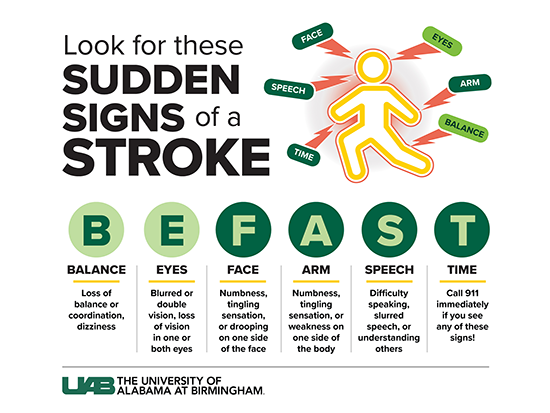Media contact: Hannah Echols
UAB Medicine This year, UAB Hospital’s Gold Plus achievement comes with the added distinctions of Target: Stroke℠ Honor Roll Elite Plus and Target: Type 2 Diabetes™️ Honor Roll.
This year, UAB Hospital’s Gold Plus achievement comes with the added distinctions of Target: Stroke℠ Honor Roll Elite Plus and Target: Type 2 Diabetes™️ Honor Roll.
Photography: Steve Wood has received the American Heart Association’s Get With The Guidelines® - Stroke Gold Plus quality achievement award for its proven dedication to ensuring all stroke patients have access to best practices and lifesaving care.
This year, UAB Hospital’s Gold Plus achievement comes with the added distinctions of Target: Stroke℠ Honor Roll Elite Plus and Target: Type 2 Diabetes™ Honor Roll.
The Stroke Gold Plus level is the most advanced level of recognition awarded by the American Heart Association and American Stroke Association. This award is earned by hospitals with a commitment to ensuring stroke patients receive the most appropriate treatment according to nationally recognized, research-based guidelines, ultimately leading to more lives saved and reduced disability.
“The award from the American Heart Association is the result of the hard work of a large group of folks throughout UAB. It reflects a level of care for our stroke patients that is among the best in the country and leads to better outcomes for our patients,” said Toby Gropen, M.D., professor of neurology and director of the UAB Comprehensive Neurovascular and Stroke Center.
Stroke is the No. 5 cause of death and a leading cause of disability in the United States. Stroke occurs when a blood vessel that carries oxygen and nutrients to the brain either is blocked by a clot or bursts. When that happens, part of the brain cannot get the blood and oxygen it needs, so brain cells die. Early stroke detection and treatment are key to improving survival, minimizing disability and accelerating recovery times.
Get With The Guidelines puts the expertise of the American Heart Association and American Stroke Association to work for hospitals nationwide, helping ensure patient care is aligned with the latest treatment guidelines. Get With The Guidelines - Stroke is an in-hospital program for improving stroke care by promoting consistent adherence to these guidelines, which can minimize the long-term effects of a stroke and even prevent death.
According to Cammie Shoemaker, DNP, quality improvement manager in the Comprehensive Neurovascular and Stroke Center, the Elite Plus designation is attributed in part to UAB’s enhanced door-to-needle times for administering intravenous thrombolytics to patients with acute ischemic stroke.
The national benchmark for DTN times, once set at 60 minutes, is now moving toward a goal of 45 minutes or less. To meet this goal and refine protocols, a multidisciplinary team of leaders and physicians was formed within the stroke center.
UAB introduced the “launchpad process” to expedite patient transfer directly from the resuscitation bay to the LP area adjacent to the CT scanner.
 Learn how to identify a stroke with these signs.
Learn how to identify a stroke with these signs.
Graphic: Jody Potter“This change streamlines access to the CT scanner and enhances communication among the health care team, eliminating the delays associated with moving patients between rooms,” Shoemaker said.
By prioritizing a streamlined protocol and uninterrupted flow of patient care, the stroke center successfully reduced DTN times while maintaining patient safety.
UAB Hospital also met specific scientific guidelines as Alabama’s first Comprehensive Stroke Center, featuring a comprehensive system for rapid diagnosis and treatment of stroke patients admitted to the emergency department.
“The UAB Comprehensive Neurovascular and Stroke Center’s award this year underscores the extremely high level of care that we have maintained, through a close collaboration between UAB Neurology, Neurosurgery and Emergency Medicine,” said Mark Harrigan, M.D., professor in the UAB Department of Neurosurgery and an expert in stroke care. “I am very proud to be a part of this amazing operation.”
Each year, program participants qualify for the award by demonstrating how their organization has committed to providing quality care for stroke patients. In addition to following treatment guidelines, Get With The Guidelines participants also educate patients to help them manage their health and recovery at home.
To qualify for the Target: Stroke℠ Honor Roll Elite Plus recognition, hospitals must meet specific criteria that reduce the time between an eligible patient’s arrival at the hospital and treatment with thrombolytic therapy.
The American Heart Association’s Target: Type 2 Diabetes aims to ensure patients with Type 2 diabetes, who might be at higher risk for complications, receive the most up-to-date, evidence-based care when hospitalized due to stroke.
For more information about stroke care at UAB, visit uabmedicine.org/specialties/stroke. For more information on the Get With The Guidelines, visit heart.org.